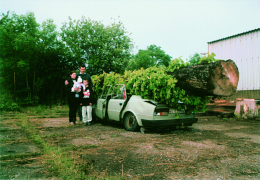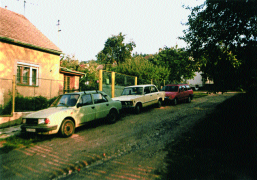The text written by Martin Zet about his "situation with the car" in Bubec was published under the title "Owning a Car is an Open Demonstration of Loyality" in the book SEBEVRAŽDA IMAGE /THE SUICIDE OF THE IMAGE, Divus publishing house, 2005-13
As soon as it was possible, my dad wanted me to immediately get my driving licence. He knew that I liked to go visit his friends with him, and he was looking forward to me driving him home after having a drink with them. But I didn't want one. I didn't want to be a slave and I was proud of being a pedestrian. A few years later I started to feel sorry for him, so I secretly got my driving licence and gave it to him as a birthday present. Whenever I could I went out driving with him. For a short time, I was able to fulfil at least this dream of his. After I finished my studies, my daddy, according to his beliefs, wished to provide for me in my life as a sculptor, so he bought me a car — a Škoda 105 L (the czech word škoda means a pity in English). For 15 years it was an inseparable part of me and my family. We went through so much together that when various states of change had matured, it wasn't possible just to sell it. It had become a part of the family. When I came up with a "final solution," I put everything in order (I even bought a new carburetor), washed it ritually for the last time and drove my family down our Marxova street. After everybody, crying, had said goodbye to the car, I set off for Bubec up Libušín’s alley of horse chestnuts.
Horse chestnut trees (the Czech word for chestnut is jírovec) have the most magical sculpture fruit. Whoever has tried to chissel a casting out of a mould knows what I am talking about. And the leaves. And the blossoms. Two horse chestnut trees were standing in front of the house in Jeřmanice where we used to go on holidays until I was 8. A log joined the two crowns from which hung either our swing or a ball for Russian skittles. And in the corner over my father's studio, where my parents were living when I was born, stood and still stands a freshly pruned horse chestnut. In addition to all of that my best friend in Gymnasium was called Martin Jírovec.
In 2001, I was invited to participate in a sculpture symposium in Bubec on the outskirts of Prague. Because a sculptor's dreams were still dwelling within me, I looked forward to getting my hands back into real craftsmanship. A couple of months beforehand I went there to check out the scene, and I chose a beautiful horse chestnut tree trunk. In the remaining time I planned out how I would make the sculpture from it. When I came to the symposium with all my tools for cutting wood, I was shocked. The whole trunk was budding with green leaves. A manifestation of the desire to grow green, to live. No way. My ecological consciousness paralysed my sculptor's heart, my desire to go into the material, and I knew that with my sharp instruments I would never touch it. That the only thing I could do was to enjoy, celebrate life together with the horse chestnut and support the resplendence of this last showing.
Even though I usually resist similar temptations, this time I gave to the created object a kind of "discursive" name: " I WANT TO HAVE AT HOME A BLOOMING HORSE CHESTNUT TREE or THE FIRST VICTORY OF DYING NATURE or THE ASCENSION OF THE PITY CAR, EVEN; unready-made." Later I changed it.
P. S.
I didn't bring the plates with the registration number to the Road Traffic Licence Department but they accepted my written justification that I couldn't give them back, as they had become an inseparable part of the art piece, and they cancelled the car.
P. P. S.
The first car — a Fiat Polski 125 P/1300 — I donated on November 2, 2000 to Divus Publishing House, as the publisher of Umělec magazine, after I was chosen to be among the TOP 10 Czech Artists. After all, every appreciation should be rewarded according to its merits. The Fiat featured in one terrible movie produced by the above-mentioned publishing house, and then the big water washed it away (the floods in 2002). The second car — the Škoda 105 L — ascended on June 16, 2001, and the third and last car, the FORD Sierra-Ghia, was sold on March 20, 2003 for a lower price to the first prospective buyer to endorse the Libušín Pedestrian Initiative.
Martin Zet, January 27, 2005 in Libušín

